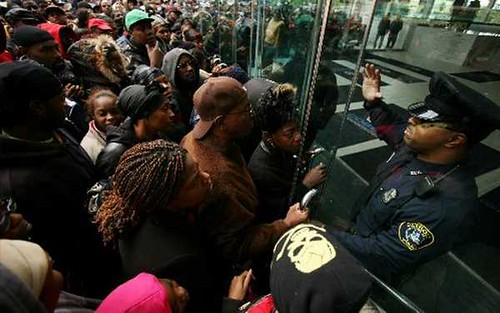
Some 50,000 people stormed Cobo Conference Center on October 7, 2009 to receive applications for federal stimulus money that would ostensibly assist with utility and mortgage payments., a photo by Pan-African News Wire File Photos on Flickr.
September 13, 2011
U.S. Poverty Rate, at 15 Percent, Is the Highest Since 1993
By SABRINA TAVERNISE
New York Times
WASHINGTON — The percentage of Americans living in poverty last year rose to the highest level since 1993, the Census Bureau reported Tuesday, fresh evidence that the disappointing economic recovery has done nothing for the country’s poorest citizens.
Another 2.6 million people slipped below the poverty line in 2010, meaning 46.2 million people now live in poverty in the United States, the highest number in the 52 years the Census Bureau has been tracking it, said Trudi Renwick, chief of the Poverty Statistic Branch at the Census Bureau.
That figure represented 15.1 percent of the population, up from 14.3 percent in 2009, and 11.7 percent at the beginning of the decade in 2001. The poverty line in 2010 for a family of four was $22,113.
And in new signs of economic distress among the middle class, median household incomes adjusted for inflation declined by 2.3 percent in 2010 from the previous year to $49,400. That was 7 percent less than the peak of $53,252 in 1999.
The report comes as President Obama gears up to pass a jobs bill, and analysts said the bleak numbers could help him make his case for urgency. But they could also be used against him by Republican opponents seeking to highlight economic shortcomings under his watch as the election season gets under way.
“This is one more piece of bad news on the economy,” said Ron Haskins, co-director of the Center on Children and Families at the Brookings Institution. “This will be another cross to bear by the administration.”
The annual report by the Census Bureau offered a portrait of the American economy one year into the economic recovery. Its findings, which included figures for poverty, median income and the number of uninsured Americans, were bleaker than many economists expected and reinforced the worry that the economy has a long way to go before middle-class families feel any improvement.
“A full year into recovery, there were no signs of it affecting the well-being of a typical American family,” said Lawrence Katz, an economics professor at Harvard. “By late 2010, the economy was sort of dead in the water, and that’s where it’s remained.”
Joblessness was the driving force pushing more Americans into poverty, economists said. Last year, about 86 million people of working age did not work even one week out of the year, Ms. Renwick said, up from 83 million in 2009, a trend of increasing long-term joblessness that economists say puts families at greater economic risk.
“Once you’ve been out of work for a long time, it’s a very difficult road to get back,” Mr. Katz said.
Median household income fell across all working-age categories, but was sharpest among the youngest Americans, ages 15 to 24, who experienced a decline of 9 percent.
According to the Census figures, the median annual income for a male full-time, year-round worker in 2010 — $47,715 — was virtually unchanged in 2010 dollars, from its level in 1973, when it was $49,065, said Sheldon Danziger, professor of public policy at the University of Michigan. Particularly hard hit, he said, were those who do not have college degrees.
“That’s not about the poor and unemployed, that’s full time, year round,” Professor Danziger said. “The median, full-time male worker has made no progress on average.”
The recession continued to push Americans, particularly young people, to double up in households with friends and family.
The group of 25-to-34-year-olds experienced a 25 percent rise in living at home in the period between 2007, when the recession began, and 2011. Of that group, nearly half were living below the poverty line, when their parents’ incomes were excluded.
“We’re risking a new underclass,” said Timothy Smeeding, director of the Institute for Research and Poverty at the University of Wisconsin, Madison. “Young, less educated adults, mainly men, can’t support their children and form stable families because they are jobless.”
More Americans fell into deep poverty, defined as less than half the official poverty line, or about $11,000, with the ranks of that group increasing to 20.5 million, or about 6.7 percent of the population.
Poverty also swallowed more children, with about 22 percent of all children living below the poverty line, up from 20.7 percent in 2009.
“It was a surprisingly large increase in the overall poverty rate,” said Arloc Sherman, senior researcher at the Center on Budget and Policy Priorities. “We see record numbers and percentages of Americans in deep poverty.”
No comments:
Post a Comment